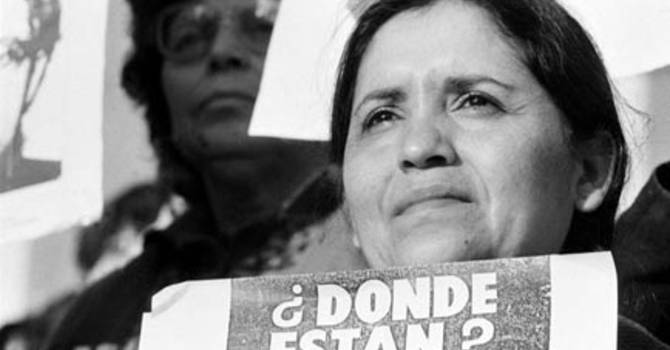He was surprised to see one of his articles published in L’Osservatore Romano: “Di fronte agli abissi che dividono poveri e ricchi” (“Facing the abysses that divide rich and poor”). The Vatican newspaper had rarely published anything about or by Scannone, who only recently turned 80. The Jesuit celebrated his birthday this week in the historic Universidad delSalvador (USAL), a Jesuit university in Buenos Aires. Then, at the beginning of April, completely out of the blue, it published an interview on his student Bergoglio and an article on the Philosophy of Liberation. A second part to this interview followed.
“In mid April I received a handwritten letter from Bergoglio,” Scannone said. “Air mail” were the only two words he had not handwritten but the rest, including the sender, F. Casa Santa Marta, Vatican City, he had. Dear cachito … he wrote to me, addressing me with the nickname I was given in the Jesuit residence of San Miguel; in the letter he thanked me for the interview. “Only talk about the good things, not the bad…”he said mockingly. The envelope contained a number of prayer cards with an image of the risen Christ.”
This was actually the second time he was contacted by Bergoglio, Pope. The first time was when Scannone had a letter sent to Bergoglio in Rome, before the Conclave started. The letter was about a Latin American network on the social doctrine of the Church, which he, Carlos Ferrero (sponsor of Mgr. Mario Toso, the Secretary of the Pontifical Council for Justice and Peace) and other Argentineans decided to create “to say something, in tune with what we want, to the new Pope when he is elected…”
When the tasks were handed out, Scannone was asked to pass on the news about the creation of this new network, to cardinals Rodriguez Maradiaga, Francisco Javier Errázuriz and Bergoglio. “He was in Rome, so I sent the letter to the email address of the Buenos Aires Curia, asking for it to be forwarded to him, wherever he was at that time.”
What happened to Bergoglio next is common knowledge. But not the fact that Pope Francis wrote to Scannone the day after his election to thank him for the letter and not various other things which his former teacher prefers to keep confidential.
Liberation theologian, Scannone, had always felt Bergoglio’s support when the latter was a superior. “He was familiar with all my writings,” Scannone said. “I cannot say he agreed with everything I wrote but he certainly approved them and read what I wrote about Liberation Theology during the military dictatorship; when bishops asked him about me he defended me by saying that my views were linked to the Church.”
It was Bergoglio in fact who encouraged him to publish what he wrote. “When international magazines asked me to send in articles … Mexico’s Christus asked me to write about the relationship between theory and practice in liberation theology,Concilium … he encouraged me to accept and recommended that I did not send my articles from the San Miguel post office but from the post offices in central Buenos Aires, in order to avoid potential censorship here.”
Fr. Scannone knew that the military was keeping an eye on him. “As a provincial, Bergoglio had contacts among military chaplains and they told him to be careful with me because I was being watched.” This is also why Bergoglio advised him to be prudent. “He told me never to go round the neighbourhood unaccompanied because if I was kidnapped there had to be witnesses in order to intervene. At the time I was visiting a neighbourhood called La Manuelita which is where the Assumptionists studying at the Jesuit university lived. Their superior was Fr. Jorge Oscar Adur.
The military searched for him but did not find him. They did however take away two seminarists who disappeared forever. It was 4 June 1976. I remember it well because this was a special date for me. They had nothing to do with the subversion; Fr. Adur was exiled to France but in June 1980 when the Pope went to Brazil he also went to visit a nun; they agreed to meet at Porto Alegre but he disappeared when he was on his way to meet her. Operation Condor was probably behind this.”
Juan Carlos Scannone witnessed many such cases.
“I was good friends with Fr. Jorio (who was kidnapped with Francisco Jalics in 1977). Bergoglio was living here and told me about what they were doing for them. Particularly to find out who had kidnapped them: the army, the navy, the air force or the police. He found out through the military chaplains that the navy was responsible. This was why they had not been tortured, Jorio told me. Torture involved leaving kidnapping victims tied up and blind-folded, with the prison guards defecating and urinating on them until proven innocent. Then they let them have a shower, gave them clothes and flew them, unconscious, in a helicopter to the open countryside and left them there.”
Another kidnapping case that sticks in Scannone’s mind is that of a student of his, Albanesi. “Bergoglio proved he was innocent but the boy saw the face of one of his torturers and was thus condemned to death. He went to speak with the person in charge of the unit where he was being kept prisoner; he said that knowingly killing an innocent man just because he saw his torturer’s face, was a serious sin. “If you believe in hell – he said – you should know that you get sent to hell if you sin.” He saved the boy’s life.


 ametalli@gmail.com
ametalli@gmail.com

